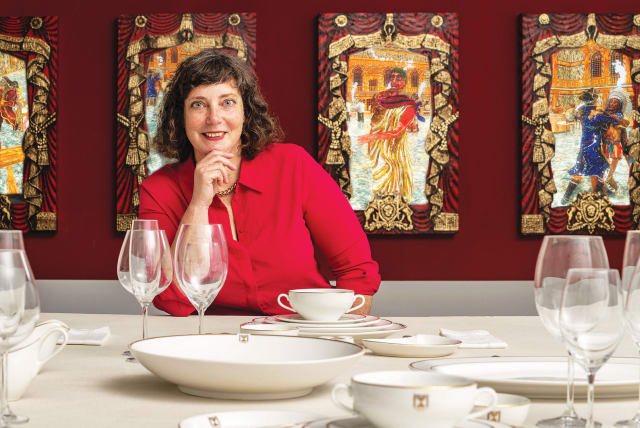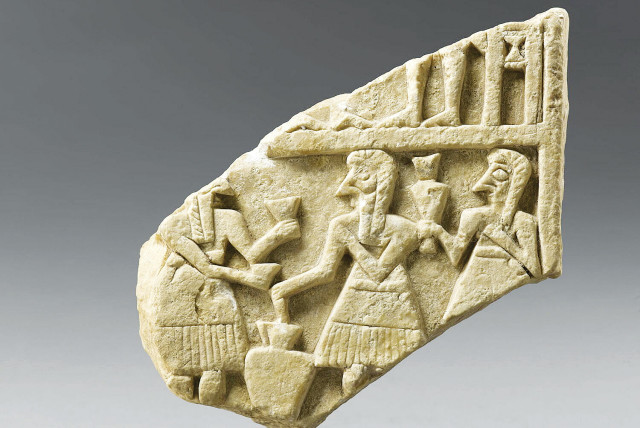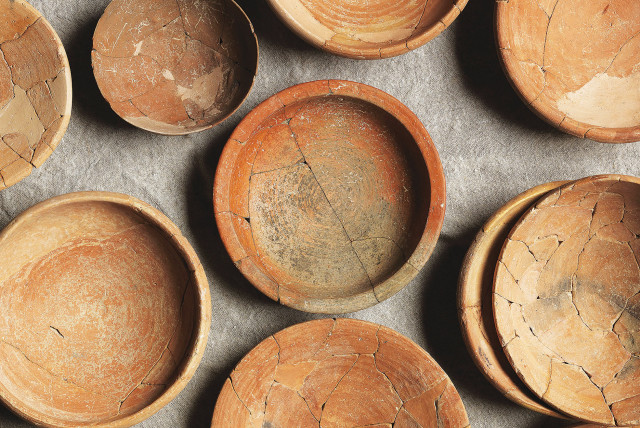The glory of ancient feasts is being revived at the Israel Museum

Shikma Brewery to produce exclusive limited-edition beer for the exhibition, based on ancient beer produced in ancient Israel.
At the inaugural banquet that King Ashurnasirpal II of Assyria threw to celebrate the completion of his new palace, in 879 BCE, in the city of Kalhu – which was to become the capital of the great Assyrian Empire – the king hosted 69,574 people who feasted for 10 days on 100 grain-fed oxen, 1,000 stable calves and sheep, 14,000 imported sheep, 500 antelopes, 1,000 big birds, 500 ducks, 500 geese, 10,000 fish, 10,000 eggs, 10,000 loaves of bread, 10,000 jugs of beer, 1,000 boxes of greens, 100 containers of parched barley, 100 containers of honey, 10 donkey-loads of shelled pistachios, and many other dishes and delicacies.
Though food may play a seemingly large part in banquets, in ancient days, much like today, the food is the excuse and not really the “main event,” noted Nurit Goshen, curator of Chalcolithic and Bronze Age archaeology at the Israel Museum, as she toured her new exhibit, The Feast.
“The main event is the people around the table, the power structure,” she explained.
The concept of the exhibit, which will run through January 31, 2024, first emerged from watching news coverage of different political ceremonies and coming to understand that the mechanism of the feasts as tools for establishing the power of rulers, leaders, and nobility, and for strengthening their ideology for 5,000 years, still exist today, she said.
Intrigued by these political-social events, Goshen began almost two years of research to reconstruct the makeup of historical banquets, looking into the different mechanisms used around the table and how they served the power ideology.
“Look at the royal wedding in Jordan, everyone is coming from around the world and there are protocols and how important it is for the image of the Hashemite family [to have people] come and honor them,” she said. “This is not new. We see the use of feasts in the political duties of rulers, both politically and religiously in ancient times, as the king was usually ruling with the “blessing” of God.”
Even a Shabbat dinner can be seen in the same framework with specific rituals and the father sitting in one place and the mother in another place; and even if today in the modern world the father is no longer sitting at the head of the table, that is also symbolic, she said.
The many faces of ancient feasts
A feast, Goshen said, can be described as any event involving two or more people consuming food and drink on an out-of-ordinary scale with some kind of ceremonial aspect.
The feast, or banquet, was a mechanism that worked at every level in the ancient world, she said. Her aim in building the exhibit was to look at the top echelons of those times, deconstructing the banquet events down to their symbols and significance. Although the trend today in popular culture is to focus on the preparation and consumption of food, the exhibit is an attempt to shift that attention to the deeper meaning and symbolism of food consumption in the context of social gatherings.
The Feast exhibition explores the banquets, feasts, and foods of the Ancient Near East from the 4th to 1st millennium BCE, showcasing their significance as a prime environment for the negotiation of ideologies and as powerful symbols of political and social standing. Religious and royal institutions utilized such festive occasions to establish and reinforce their political power while solidifying the prevailing ideology.
The exhibition endeavors to shed light on seemingly inconsequential elements of the feasts, such as the issuance of invitations, financing of the events, presentation of gifts, and the dynamics of inclusion and exclusion. It reveals how these seemingly trivial aspects are, in fact, potent tools wielded by the initiators and organizers of the events.
While the king or host provided the brunt of the food and drink at the lavish affairs, guests were expected to bring an offering as well, noted Goshen, and the luxurious gifts ranged from animals and other foods to perfumed oils and jewelry.
“There were protocols about who brought what according to their status,” she said.
Exhibited thematically rather than chronologically, the exhibit is divided into three main sections.
The first space begins with the economy of the feast, the second part is devoted to the patron-role feast where the host, by virtue of his role and status, is obligated to hold such an event, and the third section focuses on the diacritic feast, which defined who had “a seat at the table” and who did not.
Ancient feasts were more than just food
The exhibition also presents several examples of contemporary culinary diplomacy that illustrate the role of feasts in socio-political systems to the present day and include modern art installations as well as an interactive table-top dining experience, with videos of people tasting banquet dishes based on ancient quasi-recipes.
A video work in the final section shows clips deconstructing modern-day receptions, and banquets, and an entire Israeli Foreign Ministry formal dinner set is laid out on a banquet table.
Showcasing selected archaeological artifacts, iconographic representations, organic material, and textual evidence from the ancient Near East, the message of the exhibit is intended to be universal, said Goshen. Most of the artifacts are from Israel’s own museum but also included are objects from the Louvre Museum, the British Museum, and the Al Thani Collection Foundation, among other collections.
“It is super exciting to have in the Israel Museum such fantastical collaboration with leading museums of the world and to have [some of the] earliest artworks on display for our audience, we couldn’t ask for more,” said Goshen.
An 8th-century BCE incised belt from Urartu in northeastern Turkey loaned from the Bible Lands Museum depicts a feast attended only by women, portraying a distinguished woman seated on a throne decorated with a lion’s paw, attended by female servants. Female gift-bearers approach her as she is entertained by female musicians, acrobats, and dancers.
One artifact on display, which specifically surprised and excited Goshen is the wooden statue of a musician playing an Egyptian harp which had been discovered at Tel Miqne-Ekron, parts of which had already been in the possession of the Israel Museum. Researcher Baruch Brandl, working with the assistance of former director of the Albright Institute of Archaeological Research Prof. Seymour Gitin, was able to properly reconstruct the figure for the first time.
Pointing to a full set of ceramic dishware used by one of the kings from Hatzor and displayed on a long banquet table, Goshen noted the distinctions in style and quality, with the tiny dishes more likely used to provide tributes to the gods, the finest “eggshell” ceramic ware probably reserved for the elites, and the rest produced for the masses.
“All these vessels were locally produced; even with the choices of vessels here [it demonstrates] how they were [showing] the pride in their culture,” she said.
A section is dedicated to the beverages imbibed at the banquets – namely wine and beer, both of which were strained in some way before drinking. The beer was very much intertwined with bread-making and the fermentation process that produced a much thicker, almost porridge-like brew. An analysis of one of the jars displayed, excavated in Tel Kari near Nahariya, revealed that it had contained red wine made with wood resin, honey, and juniper – an exclusive wine known to have been drunk by important Canaanite kings. Some vessels revealed remains from an Ethiopian honey wine called Teg.
“This means that a Canaanite king in the Levant wanted to be drinking the same special wines drunk by the greater Canaanite kings,” noted Goshen.
Interesting botanical remains such as dates, grapes for wine, olives, figs, legumes such as peas, and cereals – including the less common fenugreek – are also on display in this section.
The preparations for the exhibit presented an opportunity for an interesting side-project, bringing in Hebrew University microbiologist Prof. Ronen Hazan and a multi-disciplinary team including archaeologists and scholars from Tel Aviv University, Bar-Ilan University, the Hebrew University, and the Israel Antiquities Authority, who joined forces to isolate 5,000-year-old yeast discovered in vessels which had been used to store beer – some from Gat, the land of David and Goliath and Samson and Delilah.
Limited-edition beer for the exhibition
In cooperation with Shikma Brewery, these scholars were able to produce a limited-edition beer from the descendants of the organism of the ancient Philistine yeast. The beer will be on sale in conjunction with the exhibit. Hazan quickly issued a caveat, noting that modern technology was used to brew the beer, so it is “very delicious,” and probably not at all similar to what the ancient beer tasted like.
“For me, it is really important for visitors to experience a bit of the feast and to get a bit of the flavor. This was a great chance to collaborate,” said Goshen. “The challenge is to make archaeology relevant and to try to infuse people with the bug; so the exhibit is filled with humor and interesting facts. I need other people to love it as much as – if not more than – I do.”
At the last exhibit, at the end of the banquet table set with the Foreign Ministry dinnerware, is a lone dish in the shape of a shoe – a reminder of the faux pas that can happen in the context of a diplomatic dinner when cultural language is overlooked. The dish, designed by Tom Dixon, was used by chef Moshe Segev to serve chocolate pralines to Japanese Prime Minister Shinzo Abe at the end of a dinner hosted by Israeli Prime Minister Benjamin Netanyahu in 2018. Only, in Japanese culture, the shoe is viewed as dirty and practically despicable.
Lucky for Segev, in this century no chef has been beheaded even for offending an illustrious guest at a feast.
Jerusalem Post Store
`; document.getElementById("linkPremium").innerHTML = cont; var divWithLink = document.getElementById("premium-link"); if (divWithLink !== null && divWithLink !== 'undefined') { divWithLink.style.border = "solid 1px #cb0f3e"; divWithLink.style.textAlign = "center"; divWithLink.style.marginBottom = "15px"; divWithLink.style.marginTop = "15px"; divWithLink.style.width = "100%"; divWithLink.style.backgroundColor = "#122952"; divWithLink.style.color = "#ffffff"; divWithLink.style.lineHeight = "1.5"; } } (function (v, i) { });


